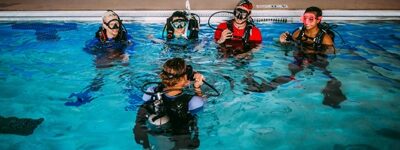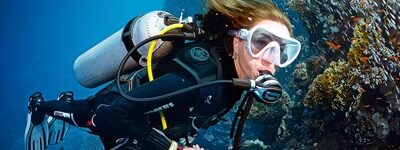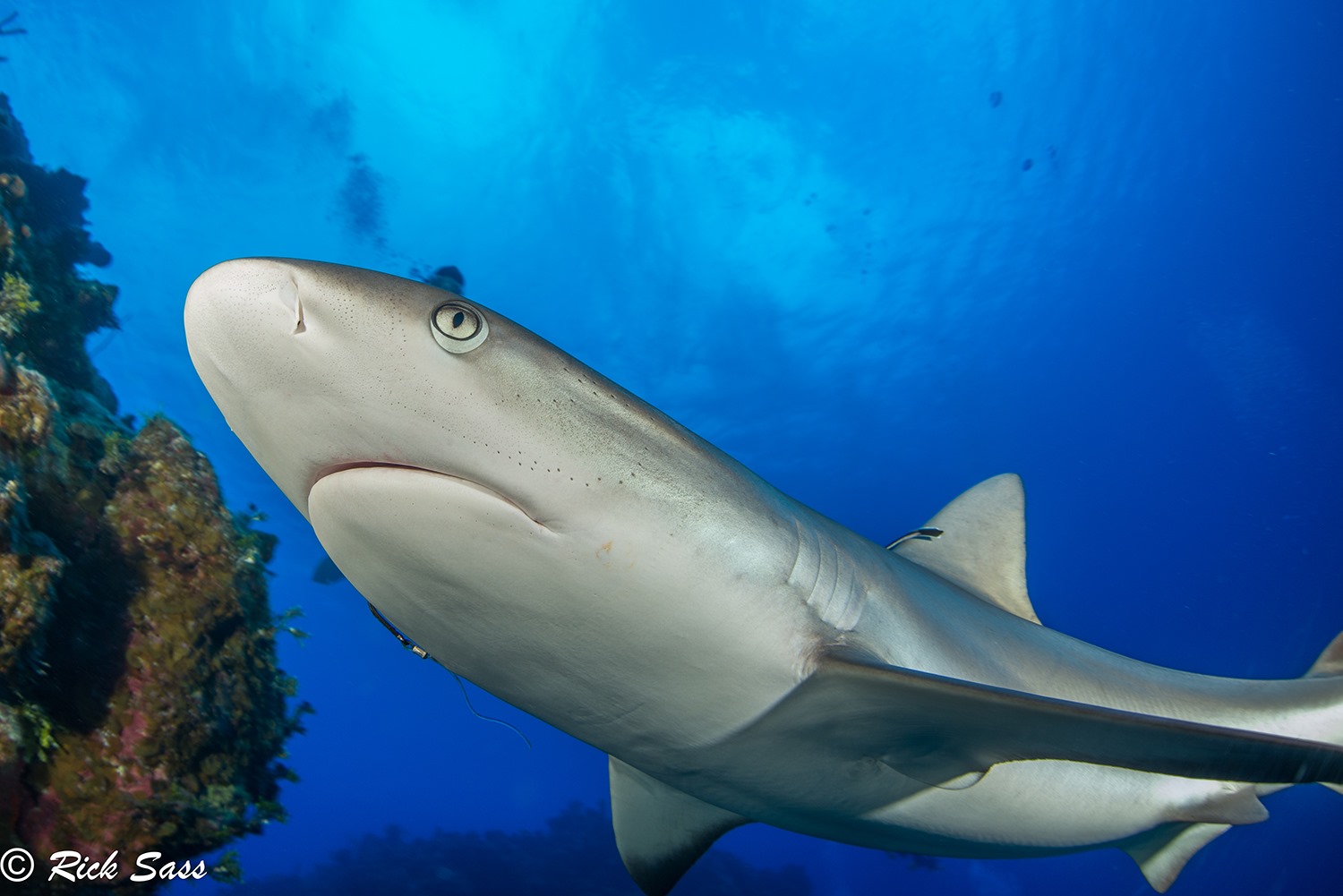
In honor of Shark Week, our team headed to the Omaha Henry Doorly Zoo and Aquarium to spend time with our underwater friends and speak with Zoo Aquarist Rebekah Bina. Rebekah shared that the aquarium is home to nine different shark species with some of the species we hadn’t heard of before! And, some are sharks our scuba divers swim with often.
Can you guess all nine species?
1. Brown Shark
Also known as the sandbar shark, the brown shark is the most common species along the U.S. Atlantic coast. They derive from the Carcharhinidae family, which in Greek translates to “sharpened nose of lead” which makes sense due to their sharp profile. They enjoy swimming along the sandy ocean floors and why they are commonly known as the sandbar shark. A brown shark’s diet consists of small, bony fish, octopus and crustaceans. Our scuba divers encounter these sharks regularly on their dives.
Brown sharks have large dorsal and pectoral fins, and their average length is between 6.5 and 8 feet. Other than humans, brown sharks do not have many predators. Although they are one of the most common species in the Atlantic, they are a vulnerable species due to shark finning. Their large size fins are highly valued in fish markets. And because they produce very few children, they are prone to overfishing.
Fun Fact: During mating season, the male will bite the female until they flip upside down. (marinebio.org)
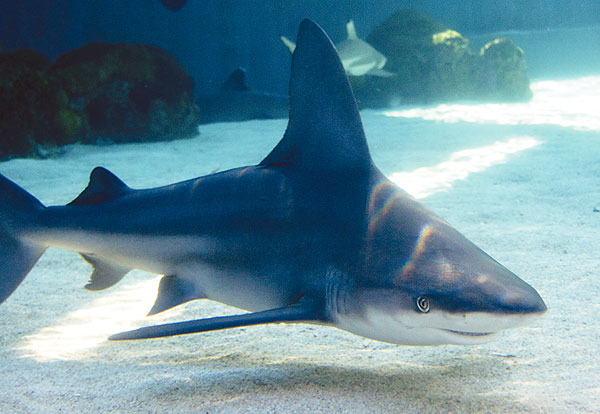
A. Reitsma. Aquarium of the Pacific
Range
Warm coastal waters, western Atlantic, global distribution
 Habitat
Habitat
Shallow waters, sandy or muddy bottoms, bays, harbors
 Family
Family
Carcharhinidae
 Size
Size
Average 6.5 ft. to 8 ft.
 Diet
Diet
Small, bony fish, octopus, crustaceans
2. Nurse Shark
Nurse sharks are the most common sharks that we see on our Diventures dive trips. They are nocturnal and spend much of the day resting near the ocean floor. At night they are much more active in their search for food. Their typical diet consists of bottom-dwelling organisms such as sting rays and crustaceans.
Even though nurse sharks have small mouths, they have strong suction. They move along the ocean floor using their barbels to detect prey, and once they find it, they suck it up just like a vacuum.
Fun Fact: Nurse sharks are known for being non-migratory. They adapt to the cold season by being less active. (oceana.org)
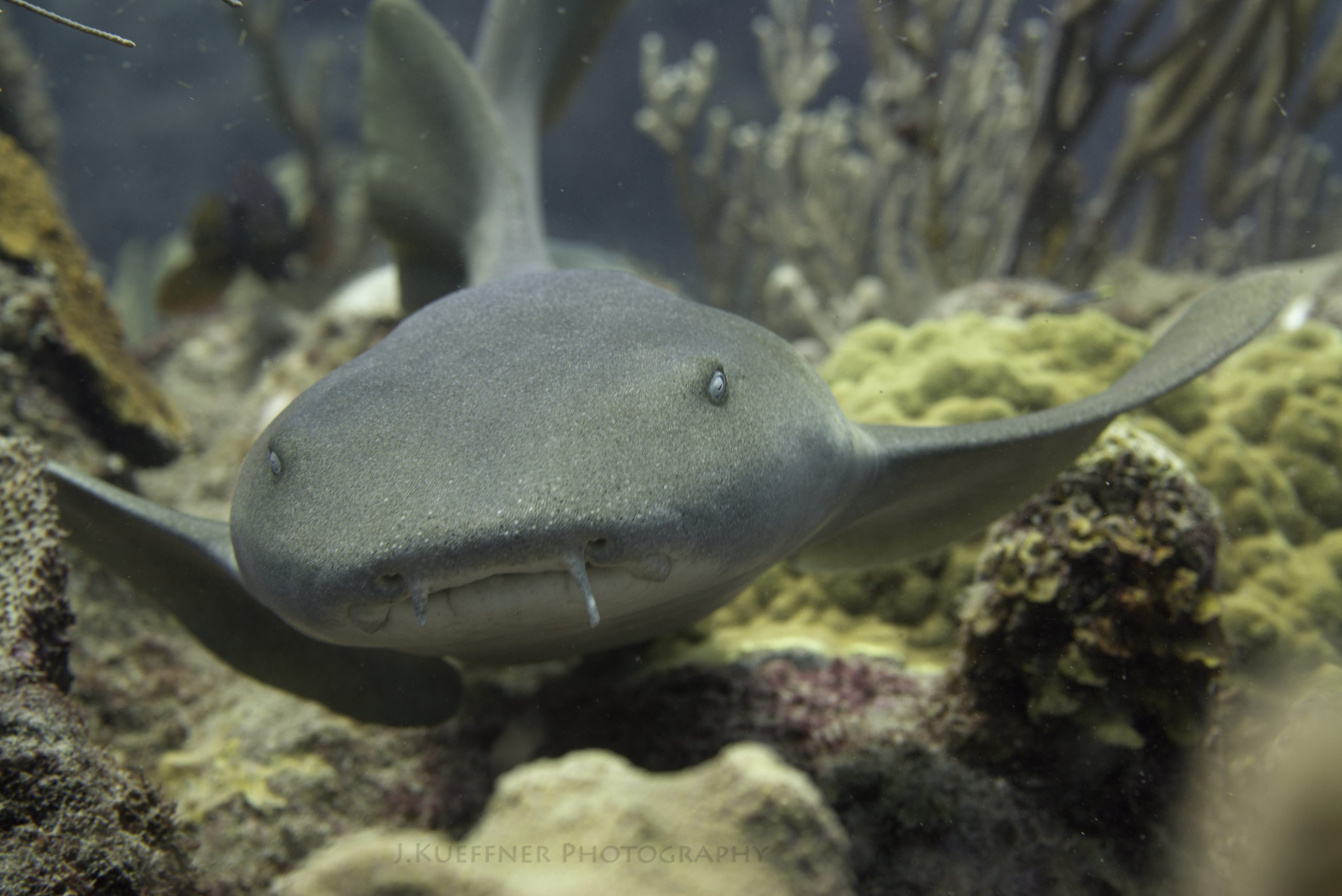
J. Kueffner Photography
Range
Tropical to temperate waters, eastern Pacific, eastern & western Atlantic
 Habitat
Habitat
Coral & rocky reefs
 Family
Family
Ginglymostomatidae
 Size
Size
Average 7.5 ft. to 9 ft.
 Diet
Diet
Bottom-dwelling organisms, sting rays, crustaceans
3. Zebra Shark
Just like nurse sharks, zebra sharks are nocturnal and like to rest during the day. They use the barbels on their snouts to search for prey, and their long and flexible bodies allow them to squeeze into narrow crevices in search of snails, shrimp and crustaceans. Their short jaws are used to grip and crush shelled invertebrates. Diventures divers swim close to these sharks regularly.
You can spot zebra sharks by their long tail and sporadic spots. They are often confused with leopard sharks because they are born with brown and white stripes across their body, but as they mature, they turn light yellow with small spots. Zebra sharks are an endangered species. Besides Australia, they are heavily fished and used in a variety of ways.
Fun Fact: Zebra sharks are often confused with leopard sharks because they are born with brown and white stripes across their body. (oceana.org)
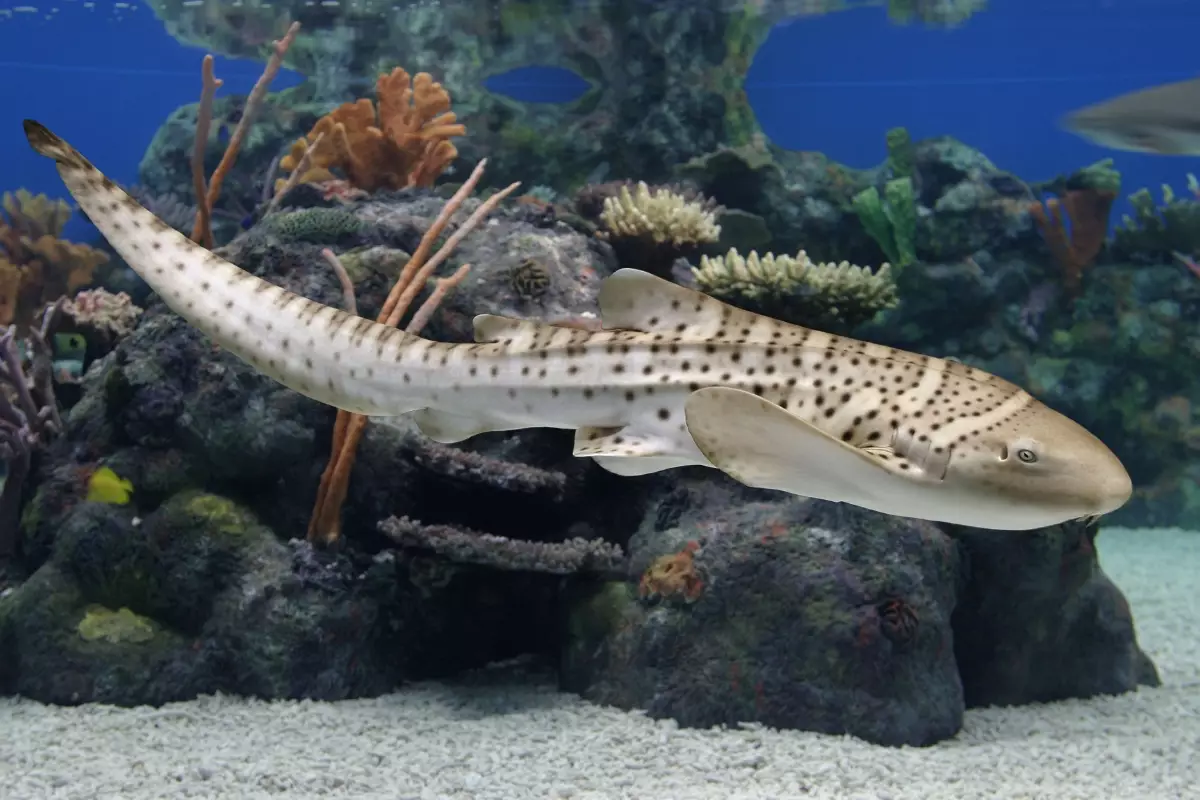
Monterey Bay Aquarium
Range
Tropical western Pacific & Indian oceans
 Habitat
Habitat
Coral reefs
 Family
Family
Stegostomatidae
 Size
Size
Up to 11.5 ft.
 Diet
Diet
Invertebrates such as snails & shrimp
4. Wobbegong
The name “wobbegong” is Australian aboriginal in origin. The exact meaning isn’t known, but it is thought to mean “living rock”. Wobbegong sharks can be found in the eastern Indian Ocean, western Queensland and southern Australia and are commonly found around coral reefs and sandy ocean floors. It is very possible for our scuba divers to spot these sharks near the reefs.
Their diet consists of octopus, crabs and lobster. Wobbegong hunt for their prey at night and lie very still on the ocean floor waiting for their prey to swim close to their mouths. Wobbegongs are ovoviviparous. This means fertilization of eggs occurs internally and are born fully formed. Females can produce up to 37 pups per litter. Wobbegongs are currently classified as a near-threatened species.
Fun Fact: The spotted wobbegong possesses a spiracle, which allows it to breathe while remaining motionless on the bottom. (Georgia Aquarium)

Andy Murch/Elasmodiver.com
Range
Eastern Indian ocean, western Queensland, southern Australia
 Habitat
Habitat
Coral reefs, under piers, sandy ocean floors
 Family
Family
Orectolobidae
 Size
Size
Up to 10.5 ft.
 Diet
Diet
Octopus, crab, lobster
5. Epaulette Shark
The epaulette shark, also known as the walking shark, spends most of its time in and around coral reefs in search of bottom-dwelling invertebrates. It is easy to spot among other sharks because of its slender body and a large, black false eyespot at the edge of each pectoral fin. Our divers can spot these sharks walking around the ocean floor if they are in just the right spot.
Since Epaulette sharks prefer to stay in shallow waters, they can be easily observed by scuba divers. They do swim, but most of their movement comes from their pectoral and pelvic fins. This movement makes it look like it is walking along the ocean floor. They are listed as a species of least concern, although overfishing and damaging fish practices have almost pushed them to a near-threatened species.
Fun Fact: Unlike most sharks, epaulette sharks do not swallow their food whole. Instead, they can be seen chewing their prey with a small portion sticking out of the mouth. (Georgia Aquarium)
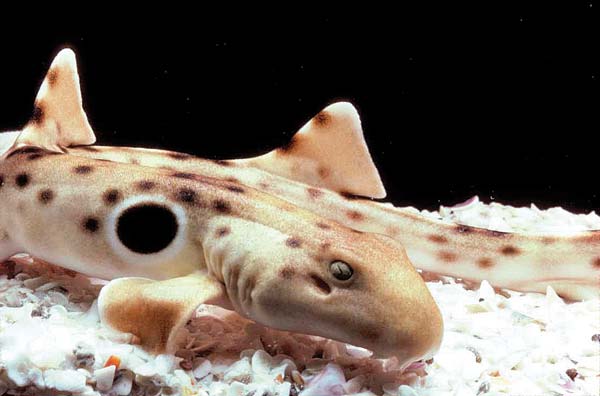
Aquarium of Pacific
Range
Southern coast of New Guinea to northern coast of Australia
 Habitat
Habitat
Warm, shallow water, coral reefs
 Family
Family
Hemiscylliidae
 Size
Size
Average 27 in. to 35 in.
 Diet
Diet
Invertebrates, crustaceans
6. Albino Bamboo Shark
Albino bamboo sharks have electroreceptors along their snout that help them find food buried in the sand and mud. Their mouths may be small, but they have strong jaws. Their muscular fins act like legs to help them crawl along the ocean floor. Since these sharks are so small, it’s hard for our divers to spot them at first, but once they do they can’t take their eyes off them.
Albino bamboo sharks are a near-threatened species because their habitats are being destroyed by dynamite and cyanide fishing.
Fun Fact: Albino bamboo sharks are also known as “cat sharks” because they have nasal barbels near their mouths that look like cat whiskers. (St. Louis Zoo)
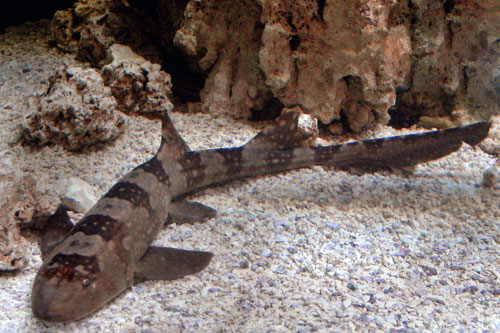
St. Louis Zoo
Range
Indo-west Pacific ocean regions
 Habitat
Habitat
Inshore tropical reefs
 Family
Family
Hemiscylliidae
 Size
Size
Between 23 in. to 31 in.
 Diet
Diet
Crab, shrimp, small fish
7. Bonnethead Shark
Unlike others of its species, bonnethead sharks have round and smooth heads, and their eyes are set far apart on each side of their head. They are migratory sharks and can be found on coastal inshores in the western Atlantic, eastern Pacific and throughout the Caribbean. Our divers have been known to spot the occasional bonnethead shark swimming quickly past them.
Bonnetheads feed during the day and eat crabs, shrimp and bony fish. Their teeth and jaws can adapt to both hard-shell and soft prey. Bonnetheads excrete a cerebrospinal fluid that is believed to let other bonnetheads know it is in the area.
Fun Fact: Bonnethead sharks are the smallest of the ten hammerhead species. (Aquarium of Pacific)
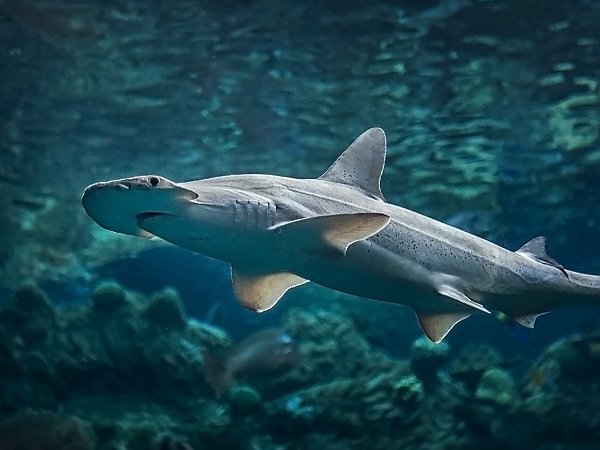
Robin Riggs
Range
Western Atlantic, eastern Pacific, Caribbean
 Habitat
Habitat
Bays, estuaries, & coral reefs
 Family
Family
Sphyrnidae
 Size
Size
Between 23 in. to 31 in
 Diet
Diet
Crabs, shrimp, bony fish
8. Swell Shark
Swell sharks are cartilaginous which means they have no bones. Since cartilage is less dense and more elastic, swell sharks use less energy to keep from sinking. Their name comes from their ability to swell their stomachs with air or water when threatened. Swell sharks are commonly found in kelp forests, and they often avoid scuba divers.
Swell sharks are not great swimmers, so they do not pursue their prey and usually wait for it to come to them. Once they find a meal in range, they suck it up with their mouths. Swell sharks are noted as a least concern species.
Fun Fact: Swell sharks lay rubbery egg cases with wiry tendrils. The tendrils catch on rocks and seaweed which anchors the egg cases and prevents them from being washed to shore. (Monterey Bay Aquarium)
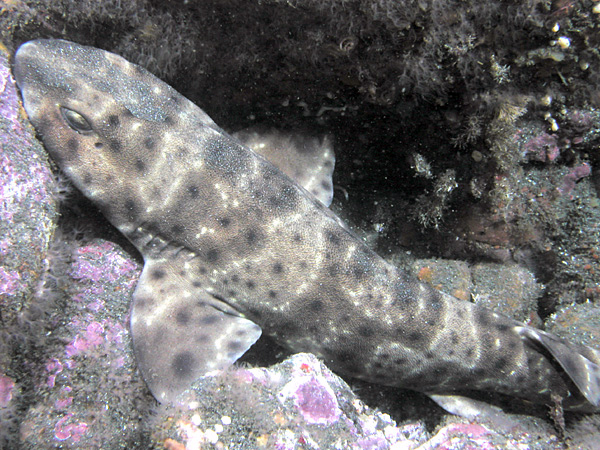
Carl Anderson Licensed Under the Creative Commons
Range
Monterey Bay, California to southern Mexico, coast of Chile
 Habitat
Habitat
Coastal waters, kelp forests
 Family
Family
Scyliorhinidae
 Size
Size
Up to 3 ft.
 Diet
Diet
Crabs, shrimp, bony fish
9. Chain Dogfish Shark
Chain Dogfish can be found in the touch tank at the Omaha Zoo. They are slim and have a distinctive dark chain pattern on their body. Chain dogfish are rare because they are only found around 200 feet or lower below the surface of the water. So, you probably won’t be seeing these guys while scuba diving.
Chain dogfish are a least concern species because they are not used for human consumption. They are a popular display at the aquarium because of their unique chain pattern and mall size.
Fun Fact: Chain dogfish also have a very special gift. They are one of only two sharks that have a type of green biofluorescence. This glow appears when blue light hits the ocean floor and is absorbed and then re-emitted. (The Guardian)
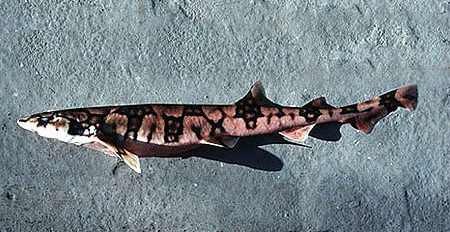
George Burgess
Range
Northwest & western central Atlantic ocean, the Caribbean Sea, Gulf of Mexico
 Habitat
Habitat
Subtropical, deep waters
 Family
Family
Scyliorhinidae
 Size
Size
Up to 18 in.
 Diet
Diet
Squid, bony fish
About Diventures:
Diventures was founded in 2009, with one location in Omaha, Nebraska. We continue to expand with more than a dozen locations across the U.S. Diventures provides concierge-level customer service for swim lessons, scuba certifications, equipment sales and service, and group and private travel. Diventures is committed to safety and fun in the water, as well as giving back to support local and global communities. Employing hundreds of people and serving thousands of customers per year, Diventures uses their passion, and the power of the water, to impact lives and change the world… and have fun doing it!
References
Animal Facts, information and pictures. Animal Corner. (2019, November 26). Retrieved July 27, 2022, from https://animalcorner.org/
Florida Museum. (n.d.). Retrieved July 27, 2022, from https://www.floridamuseum.ufl.edu/
Georgia Aquarium. (2022, July 6). Retrieved July 27, 2022, from https://www.georgiaaquarium.org/
Guardian News and Media. (2019, August 8). Scientists discover why two shark species emit green glow. The Guardian. Retrieved July 27, 2022, from https://www.theguardian.com/environment/2019/aug/08/scientists-discover-why-two-shark-species-emit-green-glow
The Marinebio Conservation Society. MarineBio Conservation Society. (2022, April 2). Retrieved July 26, 2022, from https://www.marinebio.org/
Montereybayaquarium.org. (n.d.). Retrieved July 26, 2022, from https://www.montereybayaquarium.org/
National Aquarium. (n.d.). Retrieved July 26, 2022, from https://aqua.org/
Oceana. (2022, July 1). Retrieved July 27, 2022, from https://oceana.org/
Pacific, A. of the. (n.d.). Aquarium of the Pacific. Retrieved July 26, 2022, from https://www.aquariumofpacific.org/
Saint Louis Zoo. (n.d.). Retrieved July 27, 2022, from https://www.stlzoo.org/
Shark Guardian. (1970, July 18). Retrieved July 27, 2022, from https://www.sharkguardian.org/

